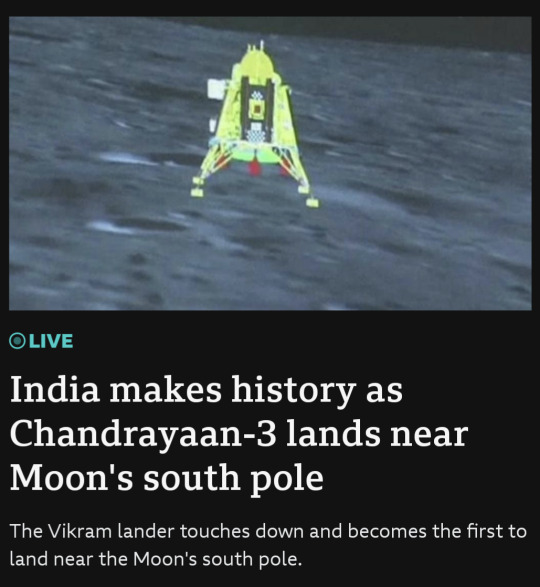#An India News
Text




#yemen#jerusalem#tel aviv#current events#palestine#free palestine#gaza#free gaza#news on gaza#palestine news#news update#war news#war on gaza#india#boycott divest sanction#direct action#bds movement
15K notes
·
View notes
Text
Scientists have developed a new solar-powered system to convert saltwater into fresh drinking water which they say could help reduce dangerous the risk of waterborne diseases like cholera.
Via tests in rural communities, they showed that the process is more than 20% cheaper than traditional methods and can be deployed in rural locations around the globe.
Building on existing processes that convert saline groundwater to freshwater, the researchers from King’s College London, in collaboration with MIT and the Helmholtz Institute for Renewable Energy Systems, created a new system that produced consistent levels of water using solar power, and reported it in a paper published recently in Nature Water.
It works through a process called electrodialysis which separates the salt using a set of specialized membranes that channel salt ions into a stream of brine, leaving the water fresh and drinkable. By flexibly adjusting the voltage and the rate at which salt water flowed through the system, the researchers developed a system that adjusts to variable sunshine while not compromising on the amount of fresh drinking water produced.
Using data first gathered in the village of Chelleru near Hyderabad in India, and then recreating these conditions of the village in New Mexico, the team successfully converted up to 10 cubic meters, or several bathtubs worth of fresh drinking water. This was enough for 3,000 people a day with the process continuing to run regardless of variable solar power caused by cloud coverage and rain.
[Note: Not sure what metric they're using to calculate daily water needs here. Presumably this is drinking water only.]
Dr. Wei He from the Department of Engineering at King’s College London believes the new technology could bring massive benefits to rural communities, not only increasing the supply of drinking water but also bringing health benefits.
“By offering a cheap, eco-friendly alternative that can be operated off the grid, our technology enables communities to tap into alternative water sources (such as deep aquifers or saline water) to address water scarcity and contamination in traditional water supplies,” said He.
“This technology can expand water sources available to communities beyond traditional ones and by providing water from uncontaminated saline sources, may help combat water scarcity or unexpected emergencies when conventional water supplies are disrupted, for example like the recent cholera outbreaks in Zambia.”
In the global rural population, 1.6 billion people face water scarcity, many of whom are reliant on stressed reserves of groundwater lying beneath the Earth’s surface.
However, worldwide 56% of groundwater is saline and unsuitable for consumption. This issue is particularly prevalent in India, where 60% of the land harbors undrinkable saline water. Consequently, there is a pressing need for efficient desalination methods to create fresh drinking water cheaply, and at scale.
Traditional desalination technology has relied either on costly batteries in off-grid systems or a grid system to supply the energy necessary to remove salt from the water. In developing countries’ rural areas, however, grid infrastructure can be unreliable and is largely reliant on fossil fuels...
“By removing the need for a grid system entirely and cutting reliance on battery tech by 92%, our system can provide reliable access to safe drinking water, entirely emission-free, onsite, and at a discount of roughly 22% to the people who need it compared to traditional methods,” He said.
The system also has the potential to be used outside of developing areas, particularly in agriculture where climate change is leading to unstable reserves of fresh water for irrigation.
The team plans to scale up the availability of the technology across India through collaboration with local partners. Beyond this, a team from MIT also plans to create a start-up to commercialize and fund the technology.
“While the US and UK have more stable, diversified grids than most countries, they still rely on fossil fuels. By removing fossil fuels from the equation for energy-hungry sectors like agriculture, we can help accelerate the transition to Net Zero,” He said.
-via Good News Network, April 2, 2024
#water#water scarcity#clean water#saline#desalination#off grid#battery technology#solar power#solar energy#fossil fuels#water shortage#india#hyderabad#new mexico#united states#uk#united kingdom#good news#hope#aquifers
857 notes
·
View notes
Text
so far, nearly 3 weeks on from the inauguration of ram mandir, indian authorities have demolished as many masjids and/or madrasas.
30.01.24 - akhoonji masjid & madrasa in delhi, also destroying a cemetery, shrine and all the students’ belongings in the process.
01.02.24 - a madrasa in maharashtra despite facing opposition from local muslims and one day before its scheduled court appeal.
08.02.24 - a masjid & madrasa in uttarakhand. this comes one day after uttarakhand became the first state to pass the uniform civil code (x, x) which aims to apply a ‘hindu code’ to all indians, infringing on the rights of dalits, adivasis, sikhs, christians, buddhists and muslims (i.e. anybody non-hindu) to practice their religion/lifestyle. muslim women protesting the demolition were lathi-charged (beaten with sticks) by police, a shoot-on-sight order was given resulting in 6 muslims killed and 300+ injured in the riots that followed, a curfew was put in place during which hindutva mobs burned down muslim homes and businesses while shouting abuse at muslims.
as always, no prior notice was given and bjp used it’s gold-standard excuse for each demolition, citing ‘illegal encroachment’.
in addition to these masjid demolitions, indian authorities bulldozed 2 neighbourhoods (ghettos, really) in the same timeframe and also without prior notice:
01.02.24 - jasola slum, which, having been around for at least 16 years, should not have been demolished without providing alternative housing, as the delhi slum policy states for slums which came up before 2015. obviously, housing hasn’t been provided.
06.02.24 - panchsheel nagar in mumbai which, having been around since 2011, entitled residents to paid rehabilitation, which has also not been given. this has left over 110 families homeless.
the demographic of both neighbourhoods, surprise surprise, is overwhelmingly muslim, buddhist and dalit.
bjp is enjoying the cover it is receiving from israel’s genocide in palestine to do whatever it wants and is getting bolder by the day. this ‘bulldozer justice’ has been happening for years, but not at such a rapid rate as it is now.
#and bjp’s crimes are always underreported or not reported at all in mainstream news anyway#india#m#!
1K notes
·
View notes
Text

what an amazing day to be Indian ❤️ Congratulations to the physicists, engineers, scientists and all staff involved, this is outstanding 🎉
2K notes
·
View notes
Text
Saw some old vines and got inspired:
So here y'all go, Spiderverse as Vines!
#am I late? maybe#but better late than never#getting used to use a new video editor so this was a good exercise for that#some of these might be a reach but I had fun making them so I included them anyways#okay now who to tag...#hobie brown#spider punk#miles morales#spider man#miguel o'hara#spider man 2099#gwen stacy#spider gwen#peter b parker#pavitr prabhakar#spider man india#LYLA#hope this post shows up in the tags cause usually tumblr won't let my video posts show up there for some reason#across the spider verse#atsv#spiderverse#vine#my video#my post
395 notes
·
View notes
Text

"Hey~!"
#i literally cannot get enough of my boy#tried to mimic his movie style but.....i don't know??#this time the overtones are a lot less jarring#also NEW ARTSTYLE AGAIN#“Dr Shaka: Get Shocked Back Into Life!”™#pavitr prabhakar#spider man india#atsv#spiderman#spider man fanart#spider man across the spider verse#across the spiderverse#myart#artoftheagni
2K notes
·
View notes
Text

Adorable East Indian Girl!. OMG.... she's so pretty!
#delhi#east indian#indian beauty#bengali#trans is sexy#new delhi#mumbai#karnataka#india love#india#transgirl#transgenderwoman#transgender#trans community#guys in dresses#love is love#intersex#trans is beautiful#gay fashion#gay girls#transsexual#queer culture#trans pride#queer fashion#queer fashion#queer girl#lgbtqia#queer pride#lgbtq community
531 notes
·
View notes
Text


Source
Workers rising to the moment. Solidarity
#unions#working class#workers rights#Palestine#free palestine#news#current events#India#Israel#the left#direct action
584 notes
·
View notes
Text
Where there is a major Destiel event the major international news are not far...




#destiel news channel#destiel meme#destiel#spn#supernatural#india#chandrayaan3#moon#wagner group#russia
1K notes
·
View notes
Text
Several countries commemorated Al Quds Day, an international day to express support for Palestine and oppose the Israeli occupation.















#yemen#jerusalem#palestine#free palestine#gaza#free gaza#news on gaza#palestine news#news update#war on gaza#al quds day#iran#tunisia#india#tanzania#bahrain#jordan#syria#indonesia#malaysia#shut it down for palestine#long post
1K notes
·
View notes
Text
"India’s announcement that it aims to reach net zero emissions by 2070 and to meet fifty percent of its electricity requirements from renewable energy sources by 2030 is a hugely significant moment for the global fight against climate change. India is pioneering a new model of economic development that could avoid the carbon-intensive approaches that many countries have pursued in the past – and provide a blueprint for other developing economies.
The scale of transformation in India is stunning. Its economic growth has been among the highest in the world over the past two decades, lifting of millions of people out of poverty. Every year, India adds a city the size of London to its urban population, involving vast construction of new buildings, factories and transportation networks. Coal and oil have so far served as bedrocks of India’s industrial growth and modernisation, giving a rising number of Indian people access to modern energy services. This includes adding new electricity connections for 50 million citizens each year over the past decade.
The rapid growth in fossil energy consumption has also meant India’s annual CO2 emissions have risen to become the third highest in the world. However, India’s CO2 emissions per person put it near the bottom of the world’s emitters, and they are lower still if you consider historical emissions per person. The same is true of energy consumption: the average household in India consumes a tenth as much electricity as the average household in the United States.
India’s sheer size and its huge scope for growth means that its energy demand is set to grow by more than that of any other country in the coming decades. In a pathway to net zero emissions by 2070, we estimate that most of the growth in energy demand this decade would already have to be met with low-carbon energy sources. It therefore makes sense that Prime Minister Narendra Modi has announced more ambitious targets for 2030, including installing 500 gigawatts of renewable energy capacity, reducing the emissions intensity of its economy by 45%, and reducing a billion tonnes of CO2.
These targets are formidable, but the good news is that the clean energy transition in India is already well underway. It has overachieved its commitment made at COP 21- Paris Summit [a.k.a. 2015, at the same conference that produced the Paris Agreement] by already meeting 40% of its power capacity from non-fossil fuels- almost nine years ahead of its commitment, and the share of solar and wind in India’s energy mix have grown phenomenally. Owing to technological developments, steady policy support, and a vibrant private sector, solar power plants are cheaper to build than coal ones. Renewable electricity is growing at a faster rate in India than any other major economy, with new capacity additions on track to double by 2026...
Subsidies for petrol and diesel were removed in the early 2010s, and subsidies for electric vehicles were introduced in 2019. India’s robust energy efficiency programme has been successful in reducing energy use and emissions from buildings, transport and major industries. Government efforts to provide millions of households with fuel gas for cooking and heating are enabling a steady transition away from the use of traditional biomass such as burning wood. India is also laying the groundwork to scale up important emerging technologies such as hydrogen, battery storage, and low-carbon steel, cement and fertilisers..."
-via IEA (International Energy Agency), January 10, 2022
Note: And since that's a little old, here's an update to show that progress is still going strong:
-via Economic Times: EnergyWorld, March 10, 2023
#india#solar power#renewable energy#green energy#sustainability#wind power#population grown#economic growth#developing economies#renewable electricity#carbon emissions#good news#hope#hope posting
855 notes
·
View notes
Text

#bangladesh#lgbtq#lgbtqia#lgbt pride#lesbian#lgbtq community#nonbinary#sapphic#queer#nonbinary lesbian#gay girls#new delhi#india#global#trans ftm#transmasc#ftm#trans male#ftm trans#tboy#ftm hrt#trans boy#ftm bottom
164 notes
·
View notes
Note
Whenever someone says "This would kill a Victorian child." Or "This would kill a medieval peasant." I have to think about Machete. Would he... would he survive eating a Dorito?
.
#I've never had doritos myself so I have no point of reference#I think they sell them here nowadays but it's a fairly new thing and I don't eat a lot of chips#they had spices in the past but they were extremely expensive#I think most of them had to be imported from South/Southeast Asia#India in particular#few could afford such luxury goods but if you could serve people spicy food it was a mark of wealth#so historically a lot of upper class dishes were extra flavorful#potentially to an overpowering degree maybe#it was a status thing#a dorito wouldn't kill him but I've mentioned he secretly tends to favor somewhat bland and unthreatening foods#that won't set off his sensory issues#he'll eat the various nutmeg cinnamon clove saffron ginger creations people serve to him because declining would be a massive faux pas#but it's not an enjoyable experience#answered#anonymous#give him some light broth and a little bit underseasoned chicken to eat with his watered down wine
245 notes
·
View notes
Text

they all get called pullingo and are kicked out of the city
Pavitr and Bhim Rajeshkumar and Karna Prabhakar.. the spider bros...
#they came to me in a dream. and i drew them#when i was supposed to be preparing for my exam#eugh. anyway. you are obligated to look at the boys. they are my everything#really happy with how bhim's hair came out. like. i didn't know i could do that#obligatory mention that the prabhakar bros all have really good hair. like at this point it's not even a gift. it's something more divine#karna's luscious locks bro.... i made myself jealous#will these two make an official appearance in the mythic mumbattan au? no idea#but i'll tell you this: miles warren is alive and well#also in case you couldn't tell: bheem is wearing the new spidey india suit (i updated it). he would wear it better than pavitr. just saying#like tbh that new suit is waayyy too similar to the ben reilly suit. not the hoodie the other one#so obviously everyone but pavitr will pull off that look#pavitr prabhakar#spider man india#atsv#across the spiderverse#spider man fanart#mythic mumbattan au#bhim rajeshkumar#karna prabhakar#artoftheagni
382 notes
·
View notes
Text
Indian IT Worker Designs New Eco-Friendly Sewage Treatment Method with the Sacred Cow as His Inspiration https://www.goodnewsnetwork.org/indian-it-worker-designs-new-eco-friendly-sewage-treatment-method-with-the-sacred-cow-as-his-inspiration/
Tharun Kumar began to imagine ways to build a better sewage treatment method that could produce good quality water without chemicals.
In 2017, Kumar started ECOSTP with the chambered stomach of the cow as his “bovine inspiration.”
Typical wastewater plants use aerobic bacteria, or metabolism with oxygen, to break down sewage, but this requires the ventilation system that continually runs on energy. Regular sewage treatment also tends to use chemicals, and has the presence of a full-time employee. Kumar has eliminated almost all of these drawbacks.
At the base of the ECOSTP septic tank is a layer of cow dung that provides the bacterial workers. With the water moving via gravity, it enters the second bacterial chamber before passing into the third space which is a filter of sand and gravel. The fourth chamber lies under a garden of select vascular plants which removes suspended solids, pathogens, nitrogen, and phosphorus, the latter two going to feed the plants.
The resulting water is graded by health inspectors as good quality for toilet water and gardening applications. With the aid of a grant from the US-based Biomimicry Solutions, ECOSTP now has 325 clients across 22 states in India, and their septic tanks are unmanned and unpowered, saving thousands in running costs.
“We are proud to have reclaimed 2 billion liters of sewage so far without power or chemicals.”
ECOSTP is now seeing if it’s possible to identify anaerobic bacteria that can remove the harmful compounds of industrial effluent.
youtube
#good news#science#microbiology#india#waste water treatment#wastewater#green technology#biomimicry#environmentalism#environment#nature#animals#climate change#climate crisis#Youtube
253 notes
·
View notes
Text


Source
#politics#government#India#news#current events#the left#progressive#Canada#international politics#international relations
313 notes
·
View notes